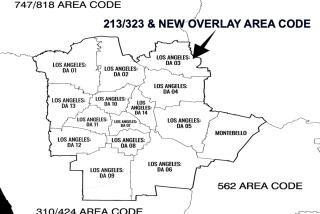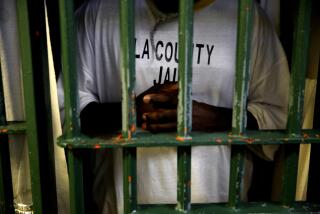310 Area Code Prepares for Longer Phone Numbes
- Share via
Beginning Saturday, Westside telephone callers will be punching more buttons than ever to make a local call--four more, to be exact.
Because of the creation of state’s first overlay dialing district, residents in the 310 area code must dial the number 1 plus the area code before all calls, even local connections.
Callers who fail to dial the entire 11-digit sequence will be connected with a recorded message telling them to start over and dial 1, plus the 310 area code, plus the seven-digit telephone number.
The change will not affect the price of calls or calls to 911 or 411.
Public utility and telephone industry representatives said Monday that the change was meant to prepare residents for the arrival July 17 of a second Westside and South Bay area code. From that date on, new telephone numbers might be assigned a 424 area code, while existing lines will retain the 310 area code.
Officials said a resident or business owner should begin thinking of his own telephone numbers as the area code plus his telephone number, and make necessary changes to telephone speed dialing, stationery and address books.
The combination of two codes within the same geographic area is known as an overlay district. More than a dozen such districts exist elsewhere in the United States, but this is the first overlay district created in California. Plans are in the works for five more.
The California Public Utilities Commission voted to establish the overlay district because the state was running out of telephone numbers, according to utility officials. “There’s an insatiable demand for new numbers,” said Elaine Camuti, a utility and telephone industry spokeswoman.
Growth in population, the method in which telephone lines are allotted to telephone companies and the proliferation of pagers, cellular phones, modems, fax machines and other technology are causing the numbers crunch.
The 310 area code serves all customers in the Westside and South Bay areas of Los Angeles County, and a very small portion of Ventura County. Communities in the area include San Pedro, Avalon, Wilmington, Compton, Torrance, Gardena, Redondo Beach, El Segundo, Santa Monica, West Los Angeles, Malibu, most of Beverly Hills and Culver City and part of West Hollywood. Commissioners approved the 310 overlay in 1998, saying that it was preferable to splitting the Westside and South Bay geographically and assigning them individual codes.
During a news conference at Loyola Marymount University, a utilities commissioner said the overlay would not be the last area code change needed in this region.
“A kid can enter undergraduate at Loyola and expect to have an area code split while the kid is here,” said Commissioner Josiah Neeper.
More to Read
Sign up for Essential California
The most important California stories and recommendations in your inbox every morning.
You may occasionally receive promotional content from the Los Angeles Times.













